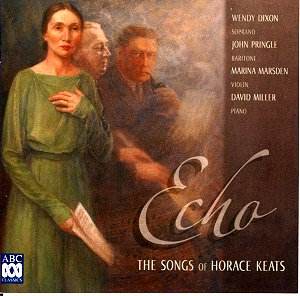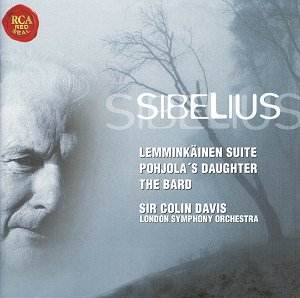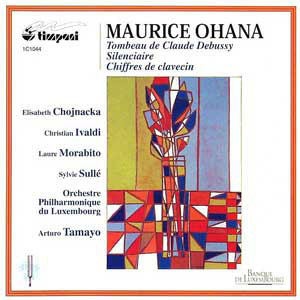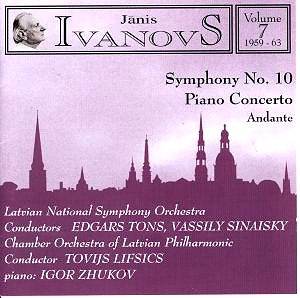 Composer: Horace Keats
Composer: Horace Keats
Works: Yellow Bracken (1937), In What Other Places Do You Live (1941), Love’s Secret (1934), The Orange Tree (1938), Sea-Wraith (1939), Galleons (1937), We Sat Entwined (1936), Sun After Rain (1941), Am I Shut Out of Mine Own Heart (1937), White Heather (1943), Of Old, On Her Terrace at Evening (1945), The Trespass (1940), Echo (1936), Columbine (1940), The Point of Noon (1936), Moonlit Apples (1940), Spring Breezes (1939), Fear (1935), Heaven Haven (1937), Versicle (1940), Over the Quiet Waters (1943), Goldfish (1935), Plucking the Rushes (1935?), The Fishing Pools (1934), Once I Could Sit by the Fire Hour Long (1943), The Roads Beside the Sea (1942), Drake’s Call (1943), Wendy Dixon (soprano), John Pringle (baritone), Martina Marsden (violin), David Miller (piano)
Recording: Recorded 11-15 Dec 2000, ABC’s Eugene Goossens Hall, Ultimo, Sydney, Australia
Label: ABC Classics
Horace Keats, a somewhat neglected figure in the canon of English song, emerges with renewed significance in this latest release from ABC Classics. His compositions from the 1930s and 1940s represent a late-Romantic sensibility that, while not overly impressionistic, embraces the lyrical and emotive qualities of the texts he chose to set. Keats’s background as a pianist on transatlantic liners and his subsequent integration into the Australian music scene provide a rich historical backdrop to the songs, which often resonate with the folk-inflected harmonic language of his contemporaries, notably Bantock and Vaughan Williams.
The performances by soprano Wendy Dixon and baritone John Pringle offer an intriguing interpretation of Keats’s oeuvre. Both singers navigate the often high tessitura with varying degrees of success; Pringle’s baritone, warm yet at times tremulous, especially in the soaring passages of “Spring Breezes,” lacks the solid center that would anchor Keats’s expansive melodies. Conversely, Dixon brings a refreshing clarity and emotional depth to pieces like “We Sat Entwined,” articulating the poignant text with sensitivity. The interpretative choices made by both vocalists often reflect a palpable engagement with the lyrical content, though some moments feel slightly underpowered, suggesting a need for greater vocal security during the more demanding passages.
The piano accompaniment by David Miller is marked by deftness and musicality, complementing the vocal lines without overshadowing them. His handling of “The Trespass” demonstrates an impressive command of Rachmaninov’s textural nuances, while the delicate interplay in “Yellow Bracken” evokes a sense of pastoral tranquility that aligns seamlessly with the text’s imagery. The engineering quality is commendable, with the balance between voice and piano well-managed, allowing each element to shine through the recording’s warm acoustic.
Comparisons to other recordings of Keats’s work, particularly Lauris Elms’s 1972 LP, highlight a growing awareness and appreciation for this composer. While Elms’s interpretations carry a certain vintage charm, Dixon and Pringle’s performances, though not flawless, offer a contemporary lens through which to re-evaluate Keats’s music. The lush melodic contours of “Heaven Haven” and the operatic fervor of “Love’s Secret” are particularly noteworthy, drawing parallels to the emotional intensity found in Finzi’s own art songs.
This collection, rich with treasurable gems, stands as a testament to Keats’s ability to weave sentimentality with sincerity. The detailed booklet accompanying the CD enhances the listening experience, providing context and insight into the works performed. The compilation reveals a composer whose music, while perhaps overshadowed by his contemporaries, deserves a prominent place in the repertoire of English song. Horace Keats’s songs resonate with a charming allure, inviting listeners to explore the nuanced landscapes of emotion and lyricism he so skillfully conjured.



